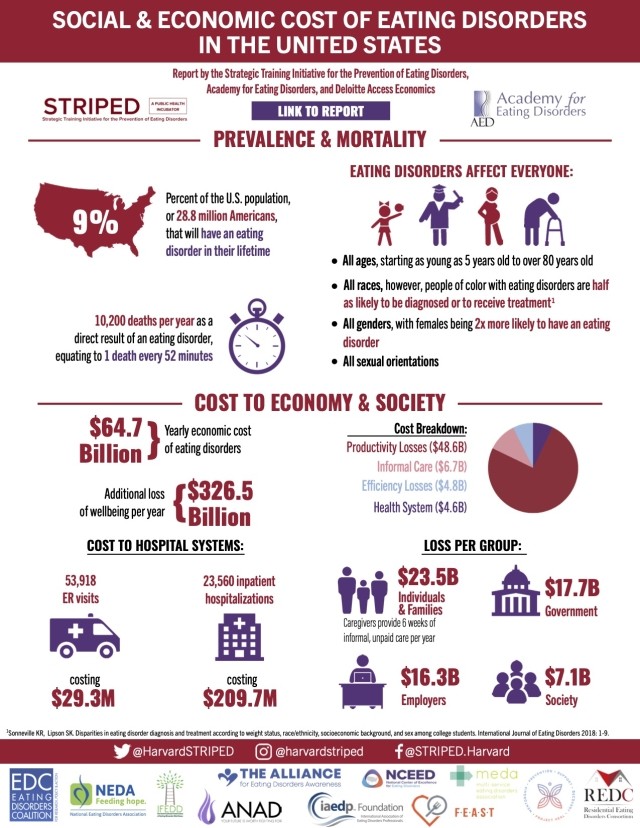Every year, Eating Disorders Awareness Week is a time for communities from all over the nation to come together to spread awareness about the different types of eating disorders and share inspirational stories of hope and recovery. We are proud to stand with our nonprofit partners and work together to shine a light on eating disorders, the importance of accessing treatment, and to show that recovery is possible.
At Eating Recovery Center, we are actively breaking the stigma around eating disorders. Our goal is to offer high-quality eating disorder treatment for those in need, support families and caregivers who need recovery resources, and to educate professionals so that they are equipped to make the right decisions when referring their patients to a higher level of care.
Here's a breakdown of some of the latest statistics around eating disorders, including statistics on anorexia, bulimia, binge eating disorder, and ARFID:

Eating disorder statistics
- 9% of the U.S. population, or 28.8 million Americans, will have an eating disorder in their lifetime.[1]
- 10,200 deaths each year are the direct result of an eating disorder – that's one death every 52 minutes.[1]
- Less than 6% of people with eating disorders are medically diagnosed as “underweight.”[2]
- Approximately 9-24% of individuals in eating disorder treatment are also experiencing post-traumatic stress disorder (PTSD), likely leading to more severe eating disorder symptoms.[3]
- 13% of women over the age of 50 have eating disorder symptoms.[4]
- Approximately 3.6% of males on college campuses have an eating disorder.[5]
- The rate of children under 12 being admitted to a hospital for eating disorders rose 119% in less than a decade.[6]
- Approximately 6-8% of adolescents have an eating disorder.[7]
View more eating disorder statistics here.
Anorexia statistics
- One in five anorexia deaths is by suicide.[8]
- In young people, the mortality rate of anorexia is 4-11%. The risk of death in young people with anorexia is 12 times higher than that for the general population of the same age. [9]
- The median age of onset of anorexia is 12.3 years, during adolescence.[10]
- One study found that nearly all adolescents with anorexia reported feeling socially impaired (88.9%).[10]
- 50-80% of the risk for anorexia is genetic.[11]
View more anorexia statistics here.
Bulimia statistics
- Around 1.5% of women will have bulimia nervosa in their lifetime.[12]
- Around 0.5% of men will have bulimia nervosa in their lifetime.[12]
- The standardized mortality ratio (SMR) for bulimia nervosa is 1.93. The SMR is a ratio between the observed number of deaths in a study population and the number of deaths that would be expected. [8]
- Around one in ten people who purge through self-induced vomiting with bulimia will experience painful cheek and face swelling.[13]
- 1 in 10 bulimia patients have a comorbid substance abuse disorder, usually alcohol use.[14]
- Fewer than half of those with bulimia nervosa have ever sought treatment for their eating disorder.[12]
View more bulimia statistics here.
Binge eating disorder statistics
- Approximately 3.5% of women will have binge eating disorder in their lifetime. [12]
- About 2% of men will have binge eating disorder in their lifetime.[12]
- Half the risk of developing binge eating disorder is genetic.[14]
- 2.8 percent of American adults will struggle with binge eating disorder in their lifetime.[12]
- Less than half of those with binge eating disorder have ever sought treatment for their eating disorder.[12]
- Following bariatric surgery, 25% of people experience loss of control eating and 5% of people experience binge eating disorders.[15]
View more binge eating disorder statistics here.
ARFID statistics
- ARFID is more common in children and young adolescents and less common in late adolescence and adulthood.[16]
- The true prevalence of ARFID is still being studied, but preliminary estimates suggest it may affect as many as 5 percent of children.[17]
- ARFID affects more males than females.[17]
- ARFID is often associated with psychiatric co-morbidity, especially with anxious and obsessive-compulsive features.[16]
- One study found that 5-14% of patients in a pediatric inpatient eating disorder treatment program had ARFID while up to 22.5% of patients in a pediatric eating disorder day treatment program had ARFID.[17]
View more ARFID statistics here.
Find help for eating disorders
Eating Recovery Center is a national leader in eating disorder treatment. To learn more about eating disorder recovery, please fill out this form or call us at (866) 622-5914.


